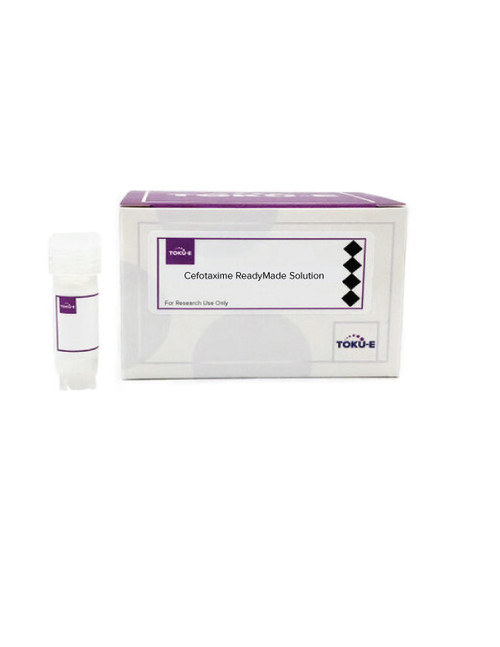Spectinomycin ReadyMadeTM solution is provided as a sterile-filtered solution of Spectinomycin Sulfate formulated in water at a concentration of 100 mg/ml. It has been filter-sterilized using a 0.22 μm filter.
Spectinomycin Sulfate is an aminocyclitol antibiotic isolated from Streptomyces spectabilis. Spectinomycin was discovered in culture broth by researchers at the Upjohn Company in 1961. Spectinomycin Sulfate shows activity against Gram-positive bacteria, Gram-negative bacteria, and Mycoplasma.
Spectinomycin Sulfate is a protein synthesis inhibitor. It acts by inhibiting protein synthesis and elongation by binding to the bacterial 30S ribosomal subunit and interfering with peptidyl tRNA translocation. This eventually leads to bacterial cell death.
Spectinomycin is commonly used as a selective agent to isolate cells that contain aadA spectinomycin resistance genes. It also has various uses in plant biology applications.
Spectinomycin Sulfate is sparingly soluble in aqueous solution.
We also offer:
| Mechanism of Action | The aminocyclitol antibiotic Spectinomycin, often considered alongside the aminoglycosides, binds in reversible fashion (hence the bacteriostatic activity) to the 16S rRNA of the ribosomal 30S subunit. There it interrupts the translocation event that occurs as the next codon of mRNA is aligned with the A site in readiness for the incoming aminoacyl-tRNA. Structural studies reveal that the antibiotic binds to an area of the 30S subunit known as the head region which needs to move during translocation. Binding of the rigid Spectinomycin molecule appears to prevent the movement required for translocation. |
| Spectrum | Spectinomycin Sulfate is broad-spectrum antibiotic active against a variety ofGram-negative and Gram-positive organisms. Anaerobic organisms are generally resistant. Spectinomycin is usually bacteriostatic. |
| Microbiology Applications |
Spectinomycin Sulfate is commonly as a selective agent to isolate cells that contain aadA spectinomycin resistance genes. Spectinomycin sulfate is typically used at concentrations between 50 - 100 µg/mL. |
| Eukaryotic Cell Culture Applications | Spectinomycin Sulfate is suitable for cell culture applications. For cell culture use, it is recommended to be used at a concentration of 7.5-20 mg/L. |
| Cancer Applications | Using 12 different human tumor cell lines representing 8 different cancer types (DCIS, breast, lung, ovarian, pancreatic, prostate, glioblastoma, and melanoma), authors found that Doxyclycline inhibited cancer stem cell propagation across this entire panel of cell lines (Lamb et al, 2015).
Doxycycline can eradicate cancer stem cells in breast cancer patients in vivo. Authors found a quantitative decease in CD44 and ALDH1 expression, biomarkers of ‘stemness’. This is promising work in using cancer stem cells for cancer prevention, and is an excellent candidate for drug repurposing (Scatena C et al, 2018). |
| Plant Biology Applications | Spectinomycin Sulfate has been use to mark cell layers to monitor cell fate during leaf development, as a selection marker in plant related transformation systems for plant cells containing the marker gene Spcr, and to generate plants deficient for the plastid-encoded RNA polymerase on Murashige and Skoog (MS) media. |
| Molecular Formula | C14H26N2O11S · H2SO4 · 4H2O |
| References |
Chopra I (2010) Modes of action, antibiotic and themotherapy. Ch. 2. In: Antiibotic and Chemotherapy. Ninth Edition. WB Saunders, pp. 10-23, ISBN 9780702040641 Davis BD (1987) Mechanism of bactericidal action of aminoglycosides. Microbiol. Rev. 51(3):341-350 PMID 3312985 Thom G and Prescott CD (1997) The selection in vivo and characterization of an RNA recognition motif for Spectinomycin. Bioorg. Med. Chem. 5: 1081-1086. PMID: 9222501 Thompson PR, Hughes DW, Cianciotto NP, Wright GD (1998) Spectinomycin kinase from Legionella pneumophila. Characterization of substrate specificity and identification of catalytically important residues J. Biol. Chem. 273 (24): 14788-14795. PMID: 9614079 Zimmerman JM, Maher JL 3rd (2002) In vivo selection of spectinomycin-binding RNAs. Nucleic Acids Res. 30: 5425-5435. PMID: 12490711
|












